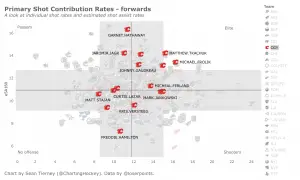You have to give Brad Treliving credit; when he said the team needed some change he certainly didn’t rest on some tinkering to alter his roster after a disappointing season.
When you topple your coaching staff, trade one of the top defensemen in the circuit, and make noise by signing one of the more sought after free agents, people take notice.
Change however, can’t merely be for the sake of change, there has to be method in madness or a management group can be guilty of merely appeasing fans without getting a whole lot done.
The Treliving attack plan this summer had some obvious targets, but also some more hidden motives that could actually have a bigger impact then what a simple perusal of a depth chart may spell out.
Coaching
The Flames made a coaching change early, a move that started out being somewhat panned in certain circles until Bill Peters had his presser and moved a lot of onlookers to the check mark side due to his comments and knowledge of the Flame’s roster.
Those with issue would point out the fact that they seemed to hire the guy they just fired. The Flames and Hurricanes were both teams with good counts but without the expected playoff appearance, suggesting the change was more in look than substance.
It’s important to point out that Bill Peters certainly had less to work with however, as the Hurricane’s are the NHL’s only chapter to show up in the bottom three in payroll in each of the last three seasons. And that’s with money spent on a goaltender that actually hurt their fortunes.
Metrics are important, as teams that get out played generally lose, but you have to do more than run up shot metrics to win in the NHL. Treliving clearly felt the existing coaching group didn’t have the tools to work with the roster as it was, or even as it was intended to be after the summer changes so a move was made.
The areas that appear to be targeted are leadership and style.
Hints this summer at season ticket meetings suggested Glen Gulutzan wanted the young core to take over the leadership with Mark Giordano and direct themselves. Brad Treliving felt the group was still pretty young, and needed a firmer hand. In Bill Peters he’s found exactly that.
But will a firm hand be enough to add offence to a team that more often than not just didn’t score enough goals to win?
Roster Changes
If Peters can’t, or if he can but needs some help by way of roster changes, Treliving was certainly active on that front as well.
Just like the team overall, the changes that occurred in Calgary this summer had more obvious targets, but also some more hidden goals that could really alter the way the team plays, and their results on the ice.
Essentially 13 players that had ice time in Calgary last season are no longer visible on the depth chart to start the season. From mid season exits of Eddie Lack and Freddie Hamilton, to the blockbuster trade with Carolina that saw Dougie Hamilton and Micheal Ferland sent packing for Elias Lindholm and Noah Hanifin, to the exodus of Calgary free agents in Matt Stajan, Kris Versteeg, Jaromir Jagr, and the buy out of Troy Brouwer the Flames said goodbye to a lot of faces.
As a result of these changes the first two obvious goals seem to have been achieved. The Flames have more depth up front, and they seem to have added a pretty impressive level of scoring behind the Sean Monahan and Johnny Gaudreau lead, dropping the reliance on too few as Treliving put it early in the summer.
The Flames can now boast ten top nine forwards, something that has not only upgraded the club’s top six, but also created a trickle down through the roster that makes the team younger, faster and potentially more dangerous throughout.
Additionally the Flames have a completely re-written their balance by adding right shot shooters in Elias Lindholm, Austin Czarnik and Derek Ryan, plus James Neal who likes top play the right side but shoots left. Ryan and Lindholm are also face off aces so they’ve given Peters a tonne of options for lines and within line for different looks.
The downside to change occurs at the top of the pyramid on the blueline with one the league’s best pairings broken up with the Hamilton departure, returning a second pairing replacement in Noah Hanifin. Can TJ Brodie bounce back and thrive with his ex partner on his preferred side? And can Hanifin mesh with Travis Hamonic in the second pairing, getting that black hole from last season filled in? The Flames have great depth and future coming from the backside, but none of those players will be able to fix the top four this season. These “ifs” need to pay off.
From a roster building standpoint the Flames may have timed the blockbuster trade perfectly when it comes to contracts, team control, selling high, and prolonging a window to win. Was 2017-18 Dougie Hamilton’s best of his career? If so this trade could very well go down as a grand slam win for the Flames if Hanifin develops on pace. However, Hamilton is 25 and has another three to four years of peak performance in him, so to suggest last season was his pinnacle could be premature. Either way it would be difficult to argue he was moved at a low point. Micheal Ferland was dealt a year away from being a UFA, and will likely get a hefty raise when he crosses that finish line. Without this trade, and with the Neal signing he likely would have fallen down the roster and not put up 20 goals again, but it was clear they dealt him at an optimum time.
Style and Substance
In my mind however, the most important change this summer will come from a less obvious things than goals, assists, face offs, and new roster looks.
Did the Flames add the types of players they were missing last year to create more scoring and chances? Do they have players that find teammates open cross seam and create more difficulty for the opposing goaltenders? Did Gulutzan and his crew tell them not to try these things? Or did he just go with what he had with an internal discussion that the Flames didn’t have enough “passers” or guys with vision on the attack?
A recent project by alan@loserpoints from HockeyGraphs attempted to tabulate shot attempts and primary passes leading to shot attempts for each NHLer. Sean Tierney then graphed the whole league in a giant shmazzal that looks like this …
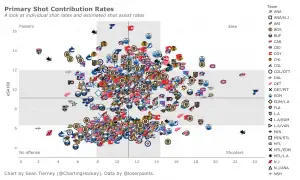 Yeah that’s a mess and doesn’t bring a whole lot to the discussion on it’s own, but it can be stripped down and it does provide a quadrant basis analysis of what hockey players bring to the table.
Yeah that’s a mess and doesn’t bring a whole lot to the discussion on it’s own, but it can be stripped down and it does provide a quadrant basis analysis of what hockey players bring to the table.
Players in the upper right quadrant are Elite as per Tierney, a good mix of shot metrics and passing metrics leading to shot attempts. Complete offensive players.
The quadrant below are the shooters. They have great shot metrics, but don’t tend to be playmakers. Rotating around to the bottom left corner and you find players that don’t contribute much in either fashion. And then clockwise we finish at the upper left corner which are playmakers that don’t shoot often enough find themselves in that Elite box.
The graph above shows all players but averages for dissections of the quadrant points are found for both forwards and defensemen.
Elite Forwards need to have 11.80 shot attempts or more in 60 minutes while also having at least 10.91 primary passes per 60 minutes that lead to a shot attempt by a linemate. For defenseman the lines are more lenient at 9.97 and 5.85 perpectively.
The 2017-18 Flames
The graph below shows the Flames from last season and where they each were found in the matrix.
It certainly won’t come as a surprise to see the 3M figure strongly in the Elite quadrant with the likes of the top line as the top heavy assertion from Brad Treliving can clearly be seen.
It should also be pointed out that the team has exercized five of the six forwards that fall in the “no offence” quadrant, leaving only Curtis Lazar who lands right on the line to the passing zone as the sole survivor. The least productive forwards in general have all moved on through free agency or a buy out to Troy Brouwer.
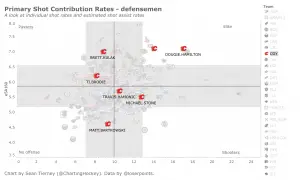 The defensemen don’t paint quite the pretty picture as the omission from last year’s roster is clearly the most productive defenseman on the grid in Dougie Hamilton.
The defensemen don’t paint quite the pretty picture as the omission from last year’s roster is clearly the most productive defenseman on the grid in Dougie Hamilton.
The good news is the keeping of the other defenseman in the elite bracket in Mark Giordano and the fact that the only defenseman to fall into no offence last year was Matt Bartkowski, who is now a member of the Minnesota Wild.
But what do the Flames have coming back?
Fist off none of the new Flames will take up residence in the “No Offence” zone, the quadrant or proximity of most of the deparatees.
With the Carolina players, the Flames add three additional “Elite” skaters with Noah Hanifin exceeding Dougie Hamilton in pass attempts, while falling quite short in shot metrics. Lindholm similarly shoots less, but has a much higher pass / 60 minutes rate than Michael Ferland. And Derek Ryan has a similar passing game to Matthew Tkachuk (Calgary’s leading forward for pass rates), though he doesn’t shoot the puck nearly enough.
Overall they all provide more passing balance to a team that had high shot metrics, but were in need of set up men.
The other additions; James Neal and Austin Czarnik are both out of the ugly quadrant as well, with Neal being a shooter and Czarnik an additional passing contributor.
But what is passing? Is there a way to dig in and look to see if the Flames are just adding more perimeter players moving the puck around, or did they in fact solve some of that home plate issue of not having the puck passed into the scoring areas? Or dialing it back a bit, did the team need to make changes at all? How did the Flames forward group line up against top offences in terms of passing the puck and creating dangerous scoring opportunities?
Frequency of Danger
Another study, that of CJ Turtoro, using data by Corey Sznajder did counts of not only passes, but the types of passes by each NHL hockey player last season. Generally, each player had 23-25 viewings, as they engineered an averaging on a decent sample size.
As a result they have tabulated a total shot assist rate per 60 minutes, as well as detailed looks at what would constitute a dangerous pass, which is that coming from across the royal road or behind the net.
The NHL averages for a Royal Road passes is 0.308 per 60 minutes, and the average for passes from behind the net at 0.447. These two added together suggests the average NHL player makes a dangerous pass 0.755 / 60 minutes, a pretty rare event. Top lines across the circuit play roughly 15 minutes a night of five on five hockey, so there is only 1/5 of a dangerous pass per game for the average player, or if grouped just over one every second game for a line. That’s not a lot.
To provide an example we will look at the top offence from the Eastern and Western Conferences, and how their top nines would roll out dangerous pass results.
Tampa Bay
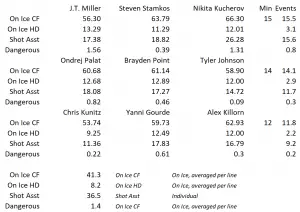 The table to the left breaks each of the Lightning lines down into the average NHL time distribution, so all rates are applied against 15, 14 and 12 minutes per night. The CF (shot attempts) are averaged for the three players, as are the High Danger chances since both measures are on ice (not individual). The Shot Assists and Dangerous passes are individual rates and are summed.
The table to the left breaks each of the Lightning lines down into the average NHL time distribution, so all rates are applied against 15, 14 and 12 minutes per night. The CF (shot attempts) are averaged for the three players, as are the High Danger chances since both measures are on ice (not individual). The Shot Assists and Dangerous passes are individual rates and are summed.
The top line is more dangerous than the second and third lines combined as they run up 0.8 dangerous passes per game, but the high danger totals are actually pretty close on a deep team with 3.1 per game on the top line, 2.9 on the second line, and 2.2 on the third line.
A great example of a deep, dangerous offensive team.
At the bottom you can see the top nine totals for the team. The Lightning create 41 shot attempts, 8 scoring chances, 37 passes that lead to shot attempts and 1.4 dangerous passes per game, five on five.
Winnipeg
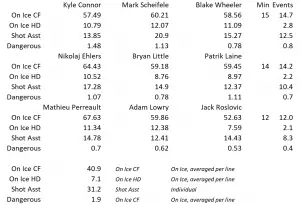 The Jets are equally as formidable but have a different look, as they generate less shot assists as a group, but have a higher rate of dangerous passes per five on give game than that of the Lightning.
The Jets are equally as formidable but have a different look, as they generate less shot assists as a group, but have a higher rate of dangerous passes per five on give game than that of the Lightning.
By line the bulk of the boost in danger is coming from their second and third lines, with Patrik Laine surely gobbling up some of those cross zone passes with one timers and wreaking havoc.
As I said in the section opening, the occurrence of these dangerous play, even from top teams isn’t all that staggering.
The Jets averaged three less shot attempts, one less scoring chance, five less shot assists, but had almost 0.5 more dangerous passes per game.
Tampa led the NHL with 296 goals last season, the Jets were tied with the Maple Leafs for second with 277.
So how did last year’s Flames measure up?
Calgary 2017-18
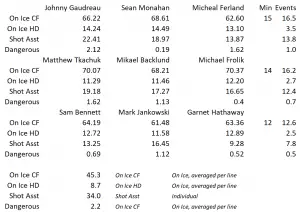 Calgary’s top line outclassed both their Winnipeg and Tampa counterparts in almost every measure.
Calgary’s top line outclassed both their Winnipeg and Tampa counterparts in almost every measure.
They put up more shot attempts, more scoring chances, more shot assists than Winnipeg (Tampa had more) and more dangerous passes leading to shot attempts than the elite of the elite in the circuit.
The difference? They didn’t finish at the same rate.
The same can be said for the rest of the top nine as the Flame’s top nine had more shot attempts, more high end scoring chances and more dangerous passes leading to shot attempts than either of the other elite offenses.
The Tampa and Winnipeg top nine scored roughly 140 goals apiece last season five on five. The Flames group? Only 116, or 26 and 21 less than the Bolts and Jets.
So what does this mean?
The Flames were a brutal offence last year. A first look at the team suggests a terrible shooting percentage was to blame since their shot metrics were near the top of the league. The next bone of contention was types of shots, and the suggestion of perimeter shooting, yet the Flames were near the top of the league in high danger shot attempts. This moved the critique on to how these high danger shot attempts came to be, that the Flames somehow managed to run up dangerous attempts in a non dangerous way, yet the dangerous pass attempts metric from an objective tabulator suggests Calgary was more productive in this fashion than that of two NHL powerhouse offences.
Though this won’t be popular, it’s necessary to point out that the Flames just may have been the least lucky team in the league last season, suggesting a bounce back was likely if not probable even without mass changes.
So who are they now?
Calgary 2018-19
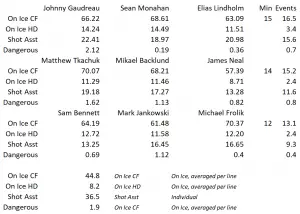 Take this look with a grain of salt.
Take this look with a grain of salt.
Any time you air lift players from other systems into the Flame’s roster when they didn’t actually generate the statistics together you get a reach. Will James Neal have more shot attempts playing in Michael Frolik’s place on the 3M line? Will Elias Lindholm run up more dangerous passes playing on the top line with garbage collector Sean Monahan and the shifty Johnny Gaudreau?
But as a starting point the table to the left suggests the Flames have taken a slight step back in shot attempts, scoring chances and dangerous passes, but a step forward in shot assists.
The numbers however, are pretty close. The top nine aggregate still lines up favourably with the Jets and Lightning from last season.
Brad Treliving has had a very busy summer. He’s altered his blueline, added depth to his forward group, and made the bottom half of his roster much more dangerous through additions that have improved the Flames through a trickle down effect.
The team was due to bounce back, something that likely will only get a shot in the arm with the reinforcements added to the returning players that are likely to see their numbers move to career averages or at least NHL averages for shooting percentages for top six and top nine forwards.
Assuming back luck and sitting on your hands is a dangerous game to play in a hockey market, Treliving instead took straight aim on said depth, a change in chemistry, and management of a club’s window through team control of key assets.
The man has always been aggressive.
But now with another coaching change you get the feeling that this is a very key season for his vision. A big step forward and the GM likely moves into Cliff Fletcher territory in terms of duration and impact in Calgary. A misstep again and maybe just maybe the ownership group loses patience.
It will be a fascinating season to watch.
Data:
Corey Sznajder@ShutdownLine
Sean Tierney@ChartingHockey
Alan@loserpoints
CJ Turtoro@CJTDevil





